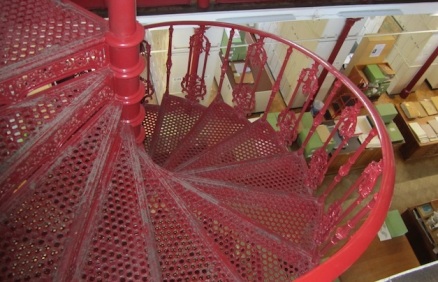
Staircase in the first building of the herbarium of the Royal Botanic Gardens, Kew.
All herbaria are basically the same. They all have cabinets filled with folders, each with specimens attached to thick sheets of white paper that are almost the same size. They may have other types of collections, but the sense you get when you enter an herbarium is usually of ranks of cabinets. However, on my visits to herbaria I have also been struck by how different they can be: in size, in collection strategies, in ancillary collections, and in their position within larger institutions. So in this series of posts, I’m going to explore some of the cultural differences among plant collections that are dependent on their institutional environments. I’ll begin with what is one of the largest categories, those affiliated with botanic gardens.
It’s probably more than coincidence that the first botanic garden, founded in 1543 in Pisa, was begun by the Italian botanist Luca Ghini who is also believed to be the originator of the herbarium somewhat earlier. Both were used to support Ghini’s teaching of materia medica at the Pisan medical school. He would take students out to the garden after class, pointing out the plants he had just described in lecture; sometimes he would show them the pressed specimen as well, so they could appreciate how drying changed a plant’s appearance. The herbarium also served as a teaching aid during the winter months. Around the time this garden was founded, Leonhart Fuchs (1542) published one of the first printed herbals with accurate plant illustrations, to supplement the information available in gardens and herbaria. These three innovations were essential to the development of early modern botany, and it’s not surprising that they are still often found together today.
Great botanical gardens usually have great herbaria and great libraries. This is true of the Royal Botanic Gardens, Kew, New York Botanical Garden (NYBG), Royal Botanic Gardens, Melbourne, and many others. From the very beginning, specimens have been supported by text; an unlabeled specimen is virtually useless. But as botany developed, sources such as Fuchs were cited as ways to link name and plant description. Books became vital references, and needed to be close at hand. The fact that the Pisa garden was attached to a university is also important. This was an institution where knowledge was passed on and generated, with specimens playing a role in both endeavors. In my next post, I’ll discuss the relationship between herbaria and education, but for now, I’ll continue with the botanic garden thread.
Many of the major botanic gardens are so large that their functions are segregated into different departments, with a library director and a herbarium director being separate functions, though there is close collaboration especially because they are often housed in the same or adjacent buildings. This is true in New York, Missouri, Kew, and Melbourne. It is a wonderful luxury to be able to go just a few steps to check a reference or to find an illustration, either in a book or in botanical art collection also housed in these libraries. The Royal Botanic Garden Edinburgh and Kew have huge collections of illustrations done by native Indian artists under the direction of botanists and physicians working for the East India Company. Such art was considered so important to systematics that these sheets were stored with the specimens. This situation is changing, and the art has been moved to the libraries, cross-referenced with the plant name and that of the artist.
But in botanical gardens, it’s the relationship between the living and preserved collections that seems to me to be most important, and in some cases closely tied to national identity. I felt this most keenly in Australia, where digitization of the national herbarium collections was first focused on Australian plants, where efforts to prevent the spread of invasive species are particularly rigorous, and where botanical artists often focus on native plants. Celia Rosser did magnificent watercolors of all the species of the quintessentially Australian genus, Banksia; vouchers made from the specimens she used are housed in several of the country’s national herbaria. There is also a sense of local pride when a garden manages to bring a particularly fussy plant into flower. Right now, corpse flowers (Amorphophallus titanum) seem to be all the rage because of their size and the awful odor the bloom exudes. Making specimens is difficult because of the flower’s size and bulk. Daniel Atha at NYBG did such a good job that the multiple sheets he created were used in an exhibit on the herbarium. More importantly, NYBG keeps a significant collection of specimens recording the cultivated plants growing in the garden, not just the celebrities.
Unfortunately, I am going to end on a sour note. NYBG’s sister garden, the Brooklyn Botanic Garden, was also linked to a magnificent library and herbarium, all three founded at the beginning of the 20th century. However, in 2013 the garden’s director summarily closed the herbarium and downsized the library’s footprint at the same time. The collection’s 300,000 specimens are now on “temporary” loan to NYBG, the library is still trying to wrestle with its lack of space, and the active environmental community in Brooklyn is left without an important resource. The links that were forged in the 16th century by Ghini and his fellow botanists have been severed. The only consolation is that these connections remain strong at many other institutions.
Note: I would like to thank all the people at the institutions I’ve visited for sharing their expertise with me.